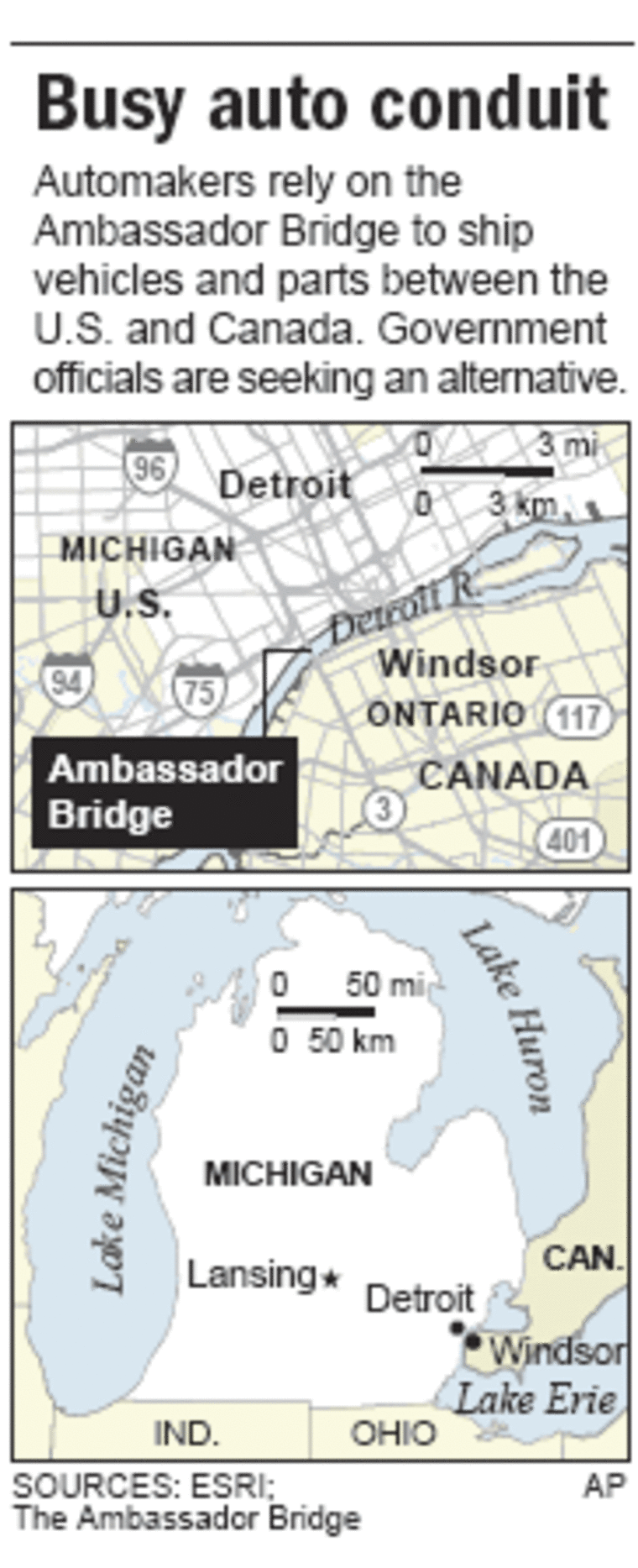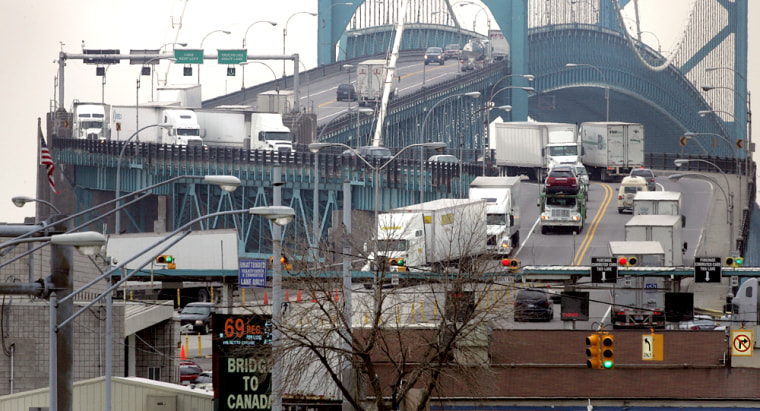Thousands of cars cross the border between Detroit and Windsor, Ontario, each day — and that’s not even counting the ones that have drivers at the wheel.
These are vehicles fresh off the assembly line, as well as parts on their way to become vehicles. A steady stream of shipments flows both ways over the border as part of the regular course of business for the auto industry. Most of it travels over a single, privately owned, four-lane bridge.
The Ambassador Bridge is the busiest vehicle border crossing in North America and the auto industry’s main conduit between the United States and Canada. Ever since Sept. 11, 2001, officials in Michigan and Ontario and at the companies that rely on the bridge have been acutely aware of the danger of this near monopoly.
A joint Canadian-U.S. commission has been studying where to locate another crossing, but a new bridge won’t be operational until 2013. Until then, the entire auto industry continues to rely on one bridge owned by one man, Manuel “Matty” Moroun.
“It’s kind of shocking that a private investor can own a crossing between two countries,” said Kim Hill, an analyst with the Center for Automotive Research in Ann Arbor. “He can impact two very large state and provincial economies.”
In Detroit, the Ambassador Bridge competes with the Detroit-Windsor Tunnel for passenger traffic. But the tunnel allows only a limited number of trucks, cannot accommodate bigger ones, and is located between two downtowns. So for big semitrailers, the nearest alternative to the Ambassador Bridge is the Blue Water Bridge, connecting Port Huron, Mich. and Sarnia, Ontario, about 60 miles to the northeast.
DaimlerChrysler AG’s Chrysler Group provides a prime example of the bridge’s importance. The company has about 1,400 to 1,500 truckloads of vehicles and parts crossing at the Ambassador Bridge every day, said Peter Weiss, Chrysler’s director of logistics. It sends about 120 trucks over the Blue Water Bridge, and about 50 over the Peace Bridge connecting Buffalo, N.Y., and Fort Erie, Ontario, he said.

It’s not just the U.S. automakers — Chrysler, Ford Motor Co. and General Motors Corp. — that need to cross the border regularly. Japan’s Toyota Motor Corp. and Honda Motor Co. also have plants in Ontario.
Government and industry started paying attention to the border issue after the terrorism attacks, when the sudden boost in security led to backups of up to 17 hours, said Tom Wickham, a GM spokesman.
Crossing the border is again fairly predictable because of an increase in the number of customs booths and government programs designed to help speed the process for approved drivers.
But the potential for future delays is worrisome for an industry that years ago moved to “just-in-time” manufacturing, in which there are no large warehouses and deliveries of parts are timed precisely to when they are needed at plants.
The Ambassador Bridge, which opened in 1929, was a commercial enterprise from the beginning, built by banker Joseph A. Bower. Bower issued stock as part of a reorganization during the Depression, but his family continued to control the bridge.
Then, in 1979, Moroun, the owner of a trucking business, bought out legendary investor Warren Buffett, who held a 25 percent stake, and became the bridge’s sole owner.
Today, Moroun’s Warren-based business empire, CenTra Inc., employs 4,500 people and includes the trucking company, the bridge, duty-free stores, and real estate holdings.
Moroun, 78, closely guards his privacy and rarely speaks to the media. In late January, he broke his silence for a rare interview with the Windsor Star, in which he defended his company and harshly criticized the binational commission that aims to build his competition.
“I would say the Ambassador Bridge over the last 35 years has done more to help the border than anybody,” he told the paper. “So what’s bad about an ownership that is private, that takes things to heart and has their hands in it for immediate action to everyone’s benefit?”
According to the Federal Highway Administration, there are seven privately owned border crossings, three on the Canadian border, including a Detroit ferry service for trucks carrying hazardous materials, and four in Texas. None of the others, however, approaches the significance of the Ambassador Bridge.
One thing all sides seem to agree on is that sooner or later, there will be a need for more border-crossing capacity between Detroit and Windsor. The binational commission forecasts that traffic at the Ambassador Bridge will reach capacity by 2010.
Moroun’s company wants to address that need by building a twin span or a wider replacement span right alongside the Ambassador Bridge.
Dan Stamper, president of the Ambassador Bridge Co., said there won’t be a need for more capacity until 2020-2030. However, he said the company is already moving forward with plans to twin the bridge.
“GM, Ford, Chrysler and other manufacturers like some certainty. That’s why we started early,” he said.
But Stamper’s plan is not enough for the border commission.
It studied the idea of twinning the bridge, but said it would not provide what is known as “redundancy,” an alternative if the bridge is shut down. Officials are looking to build a completely separate span.
But Stamper called redundancy “a red herring,” adding that terrorists could easily attack two bridges simultaneously, whether they are next to each other or not.
Stamper said the bridge company has already spent two-thirds of the money it would need to for twinning the bridge, including acquiring 90 percent of the property. The company continues to seek the necessary permits, he said.
While his company is moving forward, the commission still is in the early study phase. In a briefing to the Legislature recently, commission officials said they have narrowed the area under consideration to a 1 1/2-mile stretch south of the Ambassador Bridge.
Stamper said he worried that the commission’s work will lead to “roadblocks” for the bridge’s plan for a twin span.
“What we’re trying to convince people of is (not to) stand in our way with what we’re doing while you spend millions of dollars on this study that nobody seems to be driving,” Stamper said.
